Composite Rebar Market Size
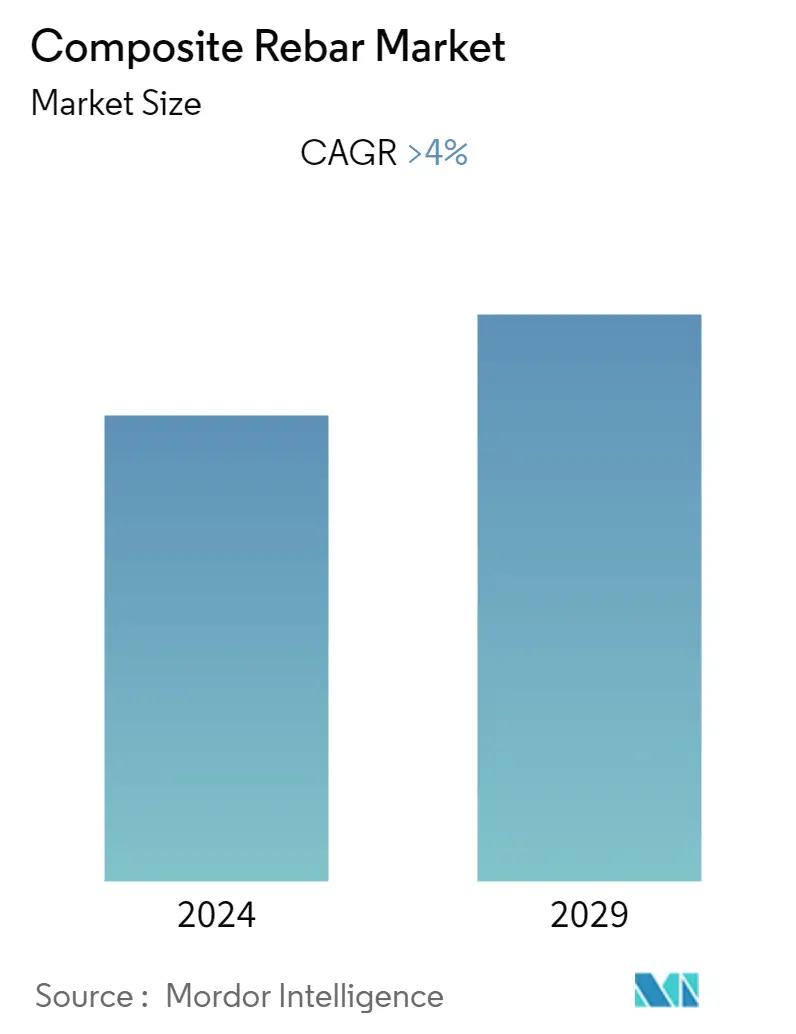
| Study Period | 2019 - 2029 |
| Base Year For Estimation | 2023 |
| CAGR | 4.00 % |
| Fastest Growing Market | Asia-Pacific |
| Largest Market | North America |
| Market Concentration | Low |
Major Players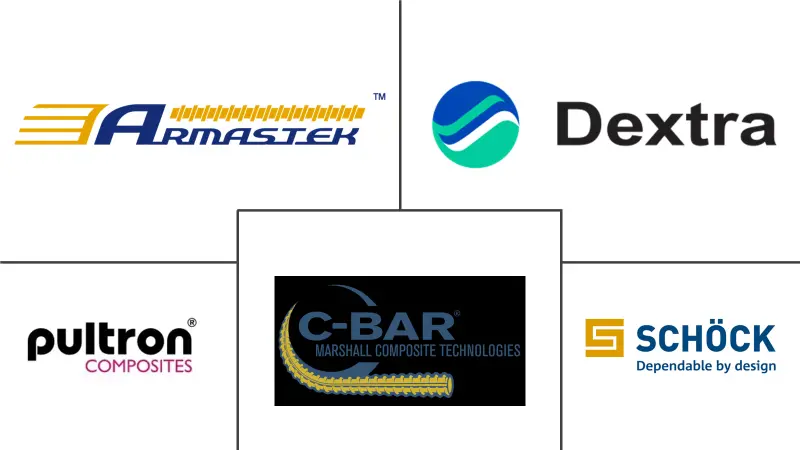
*Disclaimer: Major Players sorted in no particular order |
Composite Rebar Market Analysis
The global composite rebar market is projected to register a CAGR of more than 9% during the forecast period (2022-2027).
Composite rebars made from either carbon-fiber-reinforced or aramid fiber-reinforced polymer or glass fiber-reinforced polymer can be readily formed into complex shapes through the pultrusion manufacturing process. Composite rebars have been used by the civil engineering construction industry in the past few years. However, following the outbreak of the novel Coronavirus, nationwide lockdowns around the world, disruption in manufacturing and supply chain activities, production halts, and labor unavailability have negatively impacted the market. However, in 2021, the situation began to get back on track, and now the market is stable and growing steadily.
Over the short term, the increased usage of composite rebars in highways, bridges, and building construction activities is a driving factor stimulating the market demand.
Construction professionals and experts do not prefer using fiber-reinforced polymer rebar in concrete structure reinforcement applications due to the lack of American Society for Testing and Materials (ASTM) guidelines. This is likely to hinder the market in the forecast period.
The construction industry is growing at a fast rate in APAC countries such as India, China, and Japan due to the rising population, rapid urbanization, and huge industrial and revenue growth.
Composite Rebar Market Trends
This section covers the major market trends shaping the Composite Rebar Market according to our research experts:
Highways, Bridges & Buildings segment to Dominate the Market
Composite rebars are designed for use in corrosive and challenging environments. Composite rebars have a unique combination of mechanical properties that offer a superior alternative to other types of rebar, particularly when working in aggressive environments.
These rebars offer 1.5 to 2 times higher tensile strength than steel rebar; they also have excellent corrosion and heat resistance and durability and are lightweight.
Moreover, it is cheaper to transport composite rebars because of their lightweight nature and is quicker to install with less worker fatigue. Thus, composite rebars are used majorly in highways, bridges, and buildings segment.
Furthermore, with the rapid urbanization and rising infrastructural spending, the construction of bridges, dams, and seawalls is growing all around the globe using composite rebar.
For instance, Jizan Flood Channel, Saudi Arabia, was designed to be corrosion-free and highly chemically resistant and is the largest glass fiber reinforced polymer rebar project in the world.
Similarly, Kaikoura Highway Repair, New Zealand, uses composite rebar due to the extreme risk of corrosion and the need for sustainability and asset longevity.
Also, to achieve the goal of reducing maintenance costs and subsequent traffic delays across Old Youngs Bridge, Oregon, composite rebar was used for the cantilever bridge deck.
Furthermore, in developed and developing countries, composite rebar has also gained the interest of leaders in construction as governments and private firms alike are looking for alternative materials to increase asset life span, reduce costly repairs, and build lasting structures.
From the above-mentioned factors, the demand for composite rebars from the highways, buildings, and bridges segment is expected to grow rapidly over the forecast period.
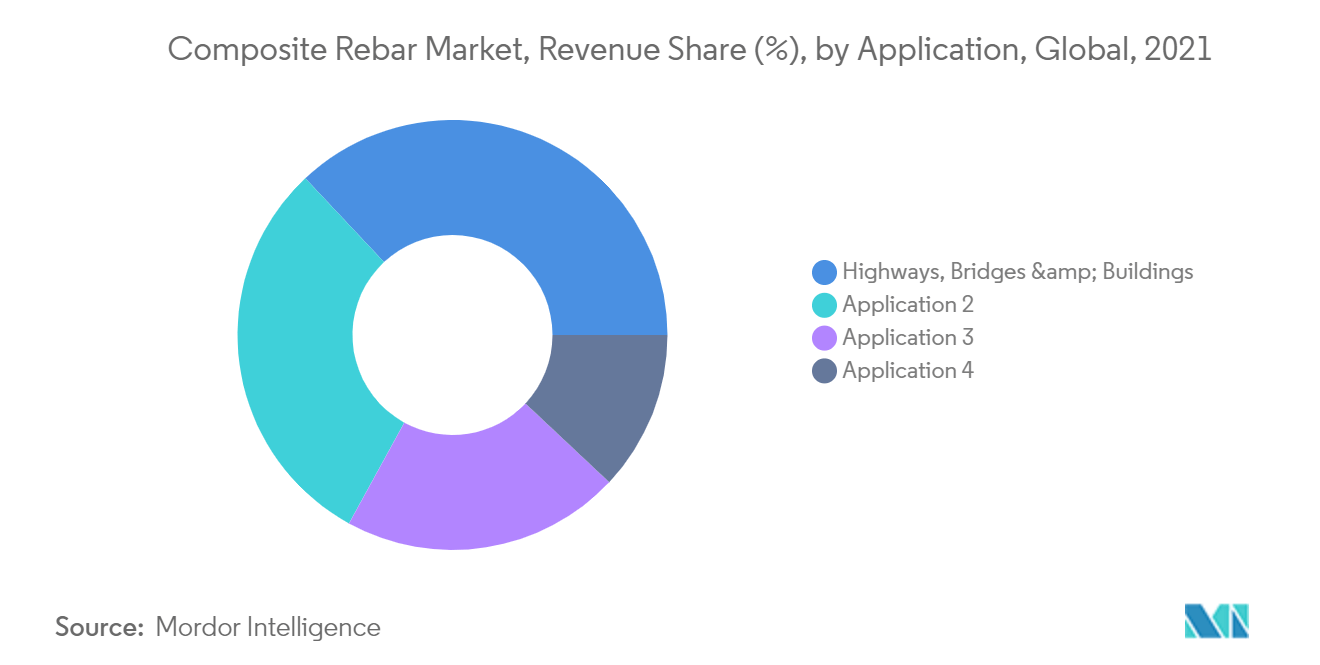
North America Region to Dominate the Market
The North American region is expected to dominate the market. In the region, the increasing construction sector in American countries like the United States, Canada, and Mexico, the utilization of composite rebar in the region is expected to increase the demand during the forecast period.
The United States has one of the world's largest construction industries, and with the new trillion-dollar infrastructure bill in effect, the country is expected to drive the market.
Additionally, the total construction spending in the country reached USD 1,779.8 billion in May 2022, which increased by ~5.8% compared to USD 1,681.0 billion in December 2020.
The current highway infrastructure in the United States and in general across North America is facing a growing deterioration problem, costing governments billions of dollars in rehabilitation costs. Considering the need for more sustainable construction materials, the significance of composite rebars rises sharply since this rebar is the ideal material for rehabilitating degraded and underperforming concrete infrastructure.
Hence, due to the above-mentioned factors, the demand for composite rebars in North America is expected to grow during the forecast period.
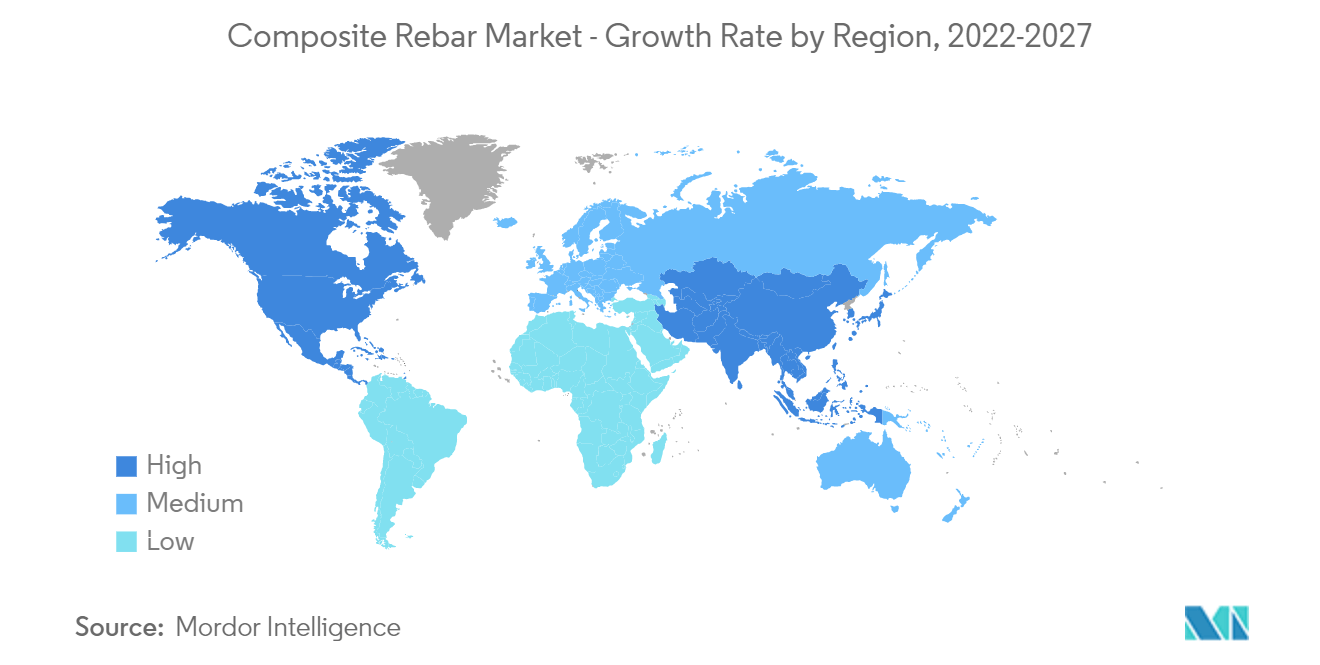
Composite Rebar Industry Overview
The composite rebar market is fragmented in nature. Some of the major players in the market include Armastek, Schock Bauteile GmbH, Dextra Group, Pultron Composites, and Marshall Composite Technologies LLC.
Composite Rebar Market Leaders
-
Armastek
-
Schock Bauteile GmbH
-
Dextra Group
-
Pultron Composites
-
Marshall Composite Technologies LLC
*Disclaimer: Major Players sorted in no particular order
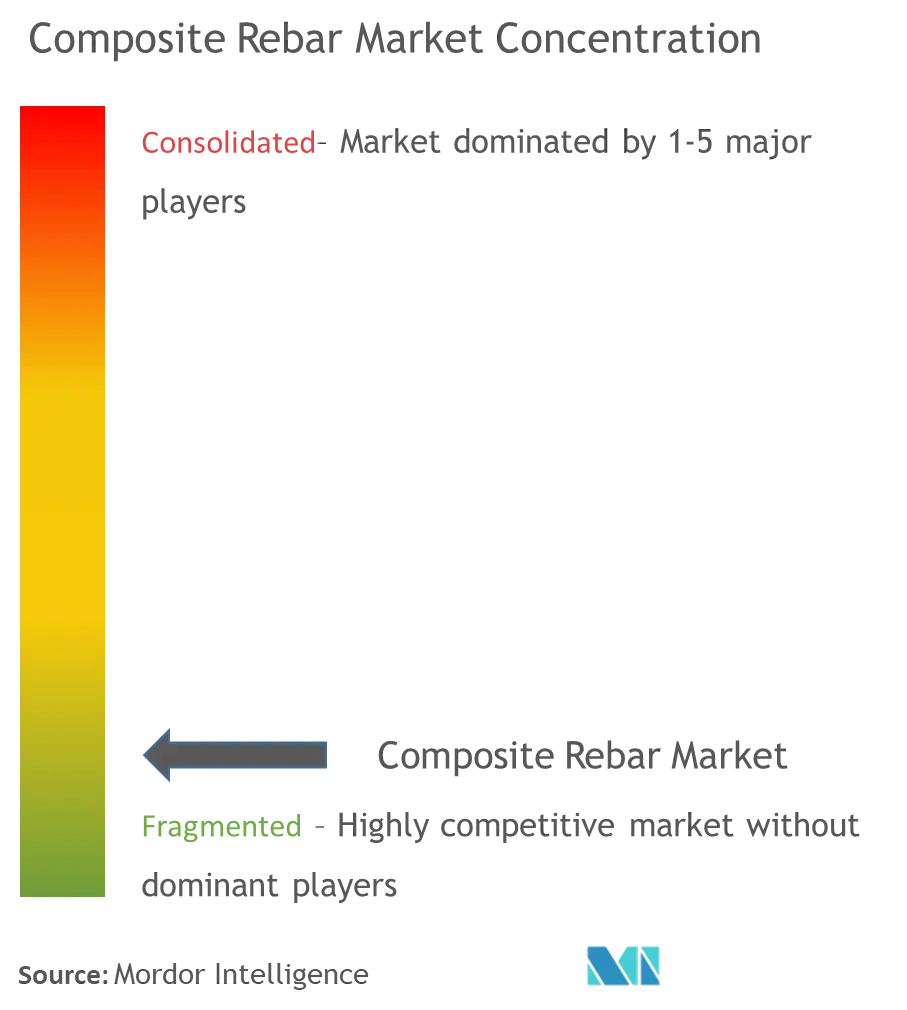
Composite Rebar Market News
- In June 2022, Pultron Composites and Owens Corning signed a joint venture to manufacture industry-leading fiberglass rebar. This helps the company to obtain greater access to the global market, including expansion in the United States.
- In July 2020, Pultron Composites made a partnership with Geosynthetic Partners Ltd. as a New Zealand and Pacific Islands distributor of Mateenbar. The partnership will help the company's expansion in the APAC region.
Composite Rebar Market Report - Table of Contents
1. INTRODUCTION
- 1.1 Study Assumptions
- 1.2 Scope of the Study
2. RESEARCH METHODOLOGY
3. EXECUTIVE SUMMARY
4. MARKET DYNAMICS
-
4.1 Drivers
- 4.1.1 Increasing Usage in Highways, Bridges, and Buildings
- 4.1.2 Increasing Demand in Marine Structures
-
4.2 Restraints
- 4.2.1 Low Acceptance of FRP Rebars Among Construction Professionals
- 4.2.2 Other Restraints
- 4.3 Industry Value-Chain Analysis
-
4.4 Porter's Five Forces Analysis
- 4.4.1 Bargaining Power of Suppliers
- 4.4.2 Bargaining Power of Buyers
- 4.4.3 Threat of New Entrants
- 4.4.4 Threat of Substitute Products and Services
- 4.4.5 Degree of Competition
5. MARKET SEGMENTATION
-
5.1 Product Type
- 5.1.1 Glass Fiber Reinforced Polymer Rebar (GFRP Rebar)
- 5.1.2 Carbon Fiber Reinforced Polymer Rebar (CFRP Rebar)
- 5.1.3 Basalt Fiber Reinforced Polymer Rebar (BFRP Rebar)
-
5.2 Application
- 5.2.1 Highways, Bridges & Buildings
- 5.2.2 Marine Structures & Waterfronts
- 5.2.3 Water Treatment Plants
- 5.2.4 Other Applications
-
5.3 Geography
- 5.3.1 Asia-Pacific
- 5.3.1.1 China
- 5.3.1.2 India
- 5.3.1.3 Japan
- 5.3.1.4 South Korea
- 5.3.1.5 Australia
- 5.3.1.6 Rest of Asia-Pacific
- 5.3.2 North America
- 5.3.2.1 United States
- 5.3.2.2 Canada
- 5.3.2.3 Mexico
- 5.3.3 Europe
- 5.3.3.1 Germany
- 5.3.3.2 United Kingdom
- 5.3.3.3 Italy
- 5.3.3.4 France
- 5.3.3.5 Rest of Europe
- 5.3.4 South America
- 5.3.4.1 Brazil
- 5.3.4.2 Argentina
- 5.3.4.3 Rest of South America
- 5.3.5 Middle-East and Africa
- 5.3.5.1 Saudi Arabia
- 5.3.5.2 South Africa
- 5.3.5.3 Rest of Middle-East and Africa
6. COMPETITIVE LANDSCAPE
- 6.1 Mergers and Acquisitions, Joint Ventures, Collaborations, and Agreements
- 6.2 Market Share (%)**/Ranking Analysis
- 6.3 Strategies Adopted by Leading Players
-
6.4 Company Profiles
- 6.4.1 Armastek
- 6.4.2 Captrad
- 6.4.3 Composite Group Chelyabinsk
- 6.4.4 Dextra Group
- 6.4.5 Fiberline Building Profiles A/S
- 6.4.6 Galen
- 6.4.7 Kodiak Fiberglass Rebar LLC
- 6.4.8 Marshall Composite Technologies LLC
- 6.4.9 Nanjing Fenghui Composite Material Co., Ltd.
- 6.4.10 Pultron Composites
- 6.4.11 Schock Bauteile GmbH
- 6.4.12 Technobasalt-Invest LLC
- 6.4.13 Tribeni Fibres Pvt. Ltd.
- *List Not Exhaustive
7. MARKET OPPORTUNITIES AND FUTURE TRENDS
- 7.1 Increasing Demand for Lightweight, High Strength, and Non-Corrosive Rebars
- 7.2 Others
Composite Rebar Industry Segmentation
The composite rebar market is segmented by product type, application, and geography. By product type, the market is segmented into glass fiber reinforced polymer rebar (GFRP rebar), carbon fiber reinforced polymer rebar (CFRP rebar), and basalt fiber reinforced polymer rebar (BFRP rebar). By application, the market is segmented into highways, bridges & buildings, marine structures & waterfronts, water treatment plants, and other applications. The report also covers the market sizes and forecasts for the composite rebar market in 16 countries across major regions. For each segment, the market sizing and forecasts have been done on the basis of value (USD million).
| Product Type | Glass Fiber Reinforced Polymer Rebar (GFRP Rebar) | |
| Carbon Fiber Reinforced Polymer Rebar (CFRP Rebar) | ||
| Basalt Fiber Reinforced Polymer Rebar (BFRP Rebar) | ||
| Application | Highways, Bridges & Buildings | |
| Marine Structures & Waterfronts | ||
| Water Treatment Plants | ||
| Other Applications | ||
| Geography | Asia-Pacific | China |
| India | ||
| Japan | ||
| South Korea | ||
| Australia | ||
| Rest of Asia-Pacific | ||
| Geography | North America | United States |
| Canada | ||
| Mexico | ||
| Geography | Europe | Germany |
| United Kingdom | ||
| Italy | ||
| France | ||
| Rest of Europe | ||
| Geography | South America | Brazil |
| Argentina | ||
| Rest of South America | ||
| Geography | Middle-East and Africa | Saudi Arabia |
| South Africa | ||
| Rest of Middle-East and Africa |
Composite Rebar Market Research FAQs
What is the current Composite Rebar Market size?
The Composite Rebar Market is projected to register a CAGR of greater than 4% during the forecast period (2024-2029)
Who are the key players in Composite Rebar Market?
Armastek, Schock Bauteile GmbH, Dextra Group, Pultron Composites and Marshall Composite Technologies LLC are the major companies operating in the Composite Rebar Market.
Which is the fastest growing region in Composite Rebar Market?
Asia-Pacific is estimated to grow at the highest CAGR over the forecast period (2024-2029).
Which region has the biggest share in Composite Rebar Market?
In 2024, the North America accounts for the largest market share in Composite Rebar Market.
What years does this Composite Rebar Market cover?
The report covers the Composite Rebar Market historical market size for years: 2019, 2020, 2021, 2022 and 2023. The report also forecasts the Composite Rebar Market size for years: 2024, 2025, 2026, 2027, 2028 and 2029.
Composite Rebar Industry Report
Statistics for the 2024 Composite Rebar market share, size and revenue growth rate, created by Mordor Intelligence™ Industry Reports. Composite Rebar analysis includes a market forecast outlook 2029 and historical overview. Get a sample of this industry analysis as a free report PDF download.



